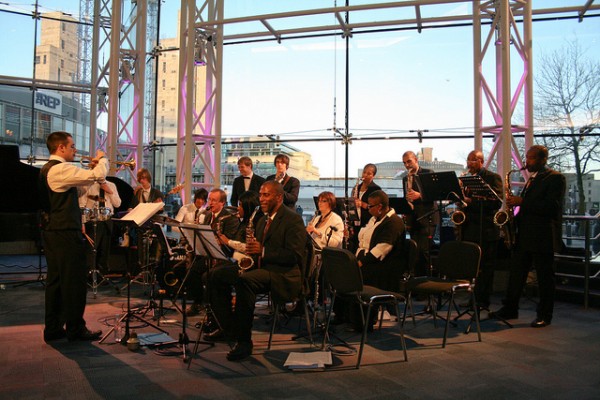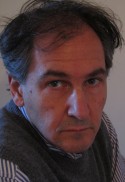
That large multicultural, multiethnic societies get along imperfectly isn’t news. But some societies get along much better than others. And certain groups unite in common purpose far more effectively than most. What are their secrets, and what can they teach the rest of us? In advance of the Zócalo event “Can Diverse Societies Cohere?,” we asked a variety of public figures to reflect on some small-scale examples of human cooperation. Maybe we can go about bridging our most dangerous social divisions from the bottom up.
Classical music is some powerful stuff
 Yes, I may have a parochial interest. I am a conductor of symphonic music and opera with a career of almost 40 years behind me. But I hope to have 20 or 25 years ahead of me as well. There are those who think that classical musicians have a vested interest in the role of classical music in society. Probably some of us do. But I am a devout believer in the spiritual power that inhabits classical music. More than a career (a term I hate) or a profession (which simply means one earns one’s living from it), music is a way of life.
Yes, I may have a parochial interest. I am a conductor of symphonic music and opera with a career of almost 40 years behind me. But I hope to have 20 or 25 years ahead of me as well. There are those who think that classical musicians have a vested interest in the role of classical music in society. Probably some of us do. But I am a devout believer in the spiritual power that inhabits classical music. More than a career (a term I hate) or a profession (which simply means one earns one’s living from it), music is a way of life.
I believe in the importance of non-sectarian spirituality and feel that whatever gives us access to the transcendent, however limited, is a necessity in life. Everything from music, literature, poetry, dance, meditation, visual arts, and sculpture to gymnastics, mountain climbing, eroticism, and wine tasting may give us a tiny peek into that transcendent realm.
As far as we know, there has never been a society without music. Each society has its own version, as do we in the United States.
What is identified as the “Western classical music tradition” draws its roots from the European Renaissance. Its unique power comes from its complexity and depth, and its presence in our lives is a necessity, not a luxury or a frill, precisely because it is different from, and not of, our contemporary society. It gives us a challenging opportunity to travel through time and space to the places and times of its origins, to the sensitivities and worldviews–and otherworldly views–of human beings of other epochs. It is a small but requisite antidote to a massive problem–that of insidious and growing provincialism.
Is classical music only for the rich? Absolutely not. (Every demographic study has debunked this inherited, worn-out notion). It is classical, almost by definition, because it holds promise for people of all walks of life at all times of history. The appreciation of classical music grows with repeated hearings and direct experience of its qualities. It binds people together. Classical music is its own tiny door to transcendence. We classical musicians make absolutely no claim to offer the only way, but our way has something special.
My love for classical music took hold of me with passionate force at the age of 11 and continues to sustain me a half-century later. Classical music is a non-toxic addiction that has the power to enrich and bind the souls of octogenarians and toddlers, rich and poor, the alienated and bored, high school dropouts and university professors, and people of all races and creeds.
James Conlon is music director of the Los Angeles Opera.
————————————-
Mind your language, mind your metaphors, and mind your history
 As Richard Sennett points out in Together, cooperation is not easy. But there are steps we can take to make cooperation more successful. My studies of jazz musicians’ jam sessions highlighted several things that jazz musicians do in order to cooperate.
As Richard Sennett points out in Together, cooperation is not easy. But there are steps we can take to make cooperation more successful. My studies of jazz musicians’ jam sessions highlighted several things that jazz musicians do in order to cooperate.
First and foremost, musicians require a common understanding of how to make music with others. That’s found in the language of music and in the conventions they are taught. A jazz player won’t get far if he can’t tell the difference between an E chord and a G chord, or if she doesn’t know the chords to a basic song like I’ve Got Rhythm.
Second, musicians share a set of metaphors. When a guitarist says he wants to “make time more solid,” he expects that others can draw on that metaphor. That way, musicians can communicate how to produce a strong, coherent performance as well built as a wall crafted by a master bricklayer.
A third key dimension of cooperation comes in the form of what linguists call “entailment.” Basically, this means that when you are cooperating with others, the things you do earlier on have an impact on what happens later on. In jam sessions, I’ve seen this at work when somebody throws in some funk rhythms in addition to jazz’s regular swing time. Once it’s been established that people can play together in the basic style, variations can be repeated throughout the evening.
Like jazz musicians, all of us need a common language in order to cooperate. We need to understand that different people make use of different metaphors to express their experiences–although perhaps this means some things, like bull’s-eyes in political ads, should be off the table. And we have to pay attention to entailment: History matters, both in the long term of events in the distant past and in the short term of particular interactions we have with others. Pay attention to what you say or do–it might come back to haunt you.
Nicholas P. Dempsey is assistant professor of sociology at Eckerd College.
————————————-
Art redirects our awareness of division into something beneficial
 I’ve worked for many years as a public artist, making murals and mosaics in collaboration with community members. I’m interested in the ways in which collaboratively designed and created artworks suggest the possibility of creating “aesthetic harmony”–a form of unity that can unite disparate elements in dynamic tension.
I’ve worked for many years as a public artist, making murals and mosaics in collaboration with community members. I’m interested in the ways in which collaboratively designed and created artworks suggest the possibility of creating “aesthetic harmony”–a form of unity that can unite disparate elements in dynamic tension.
Collaborative public artworks are monuments to connectedness; they are concrete symbols of people’s capacity to form meaningful bonds and to work together. With a collaborative artwork the goal is not to smooth over differences and create a homogeneous look. Instead, individual styles, images, and ideas are juxtaposed.
Making art together is a powerful form of eros, of the energy to make loving bonds. For many years, I have reflected on Martin Luther King’s phrase “beloved community” and the potential to work together to create a loving society that offers pleasure and justice to all its citizens.
Julia Kristeva, a French psychoanalyst, talks about the notion of “paradoxical community.” We can be individuals and part of a collective. We can feel the community’s strength, warmth, and unity, but we can also acknowledge the many different experiences and ways of processing experiences–the paradoxes, gaps, and tensions.
People have these tensions within their own psyches, but instead of experiencing, processing, or consciously sustaining these internal paradoxes, they tend to project them outward, toward those who are different. Art–making and experiencing–gives us the capacity to reconsider this divisive urge.
Participants in a public art process can be in an artistic dialogue in which they experience the tension of oppositions and lack of resolution, but there is still loving engagement. We can come to experience contemporary life as an irresolvable but fascinating conversation.
Olivia Gude is a senior artist of Chicago Public Art Group and a professor at the University of Illinois at Chicago. For more on community-based collaborative public art, see the Chicago Public Art Group’s Community Public Art Guide, www.cpag.net.
————————————-
Evolution is working–slowly–in our favor
 The next century will be dominated by social issues arising from the mass movement of people from poorer to richer areas of the world, giving rise to large societies of people with little of the common cultural identity our species historically has enjoyed, and that sculpted our peculiar tribal psychology–helpful and cooperative to other members of our “tribes,” but often wary of outsiders.
The next century will be dominated by social issues arising from the mass movement of people from poorer to richer areas of the world, giving rise to large societies of people with little of the common cultural identity our species historically has enjoyed, and that sculpted our peculiar tribal psychology–helpful and cooperative to other members of our “tribes,” but often wary of outsiders.
And yet, there is hope, because the last 80,000 years of human evolution has witnessed the steady–if often slow–triumph of cooperation over conflict and competition, as formerly competing entities learned that cooperation could return greater dividends than endless cycles of betrayal and revenge. Early in our history, tribes formed that were essentially bands of competing bands. Competing tribes gave way to chiefdoms, which in turn gave way to city- and then nation-states, and eventually to collections of states, such as the United States, the United Kingdom, the European Union, and the United Nations.
It is not that we are simply “nice.” Natural selection has created an emotion in us that derives joy from cooperation because it is a self-interested strategy, and the key to making it work is to link peoples’ fates. Right now, the nations of the European Union are, at tremendous cost, bailing out Greece, Portugal, and Spain because the economies of the European Union depend upon all these nations prospering.
At national, regional, and even community levels collections of diverse people stand the best chance of being successful when their individual fates and well-being depend upon the success of their shared efforts. It won’t be easy, but finding the means to link peoples’ fates around shared outcomes that depend upon cooperation is the social glue that has historically knitted us together.
Mark Pagel is a fellow of Britain’s Royal Society, professor of evolutionary biology at the University of Reading and an external professor at the renowned Santa Fe Institute in the U.S. He has traveled the world studying evolution and culture, and is the author of numerous scientific articles in leading journals. His latest book is Wired for Culture: Origins of the Human Social Mind.
————————————-
Creating an arts space does more good than anyone would imagine
 Take a clatch of five artists in a field notorious for its lack of audience and institutional funding. That would be experimental dance. Place them in an urban dystopia of “marked decline.” That would be Philadelphia. And have them create a governance structure with no hierarchies or seniority policies, with all decisions made through consensus. That would be a cooperative. At first glance, this does not a sustainable business model make. But the Mascher Space Cooperative, now approaching its seventh year, has become a beacon of financial stability in the arts, a powerhouse for cutting-edge performance, and a thriving resource center for artists who range from celebrated legends to fresh-out-of-school provocateurs. How does it work, and what does this teach us, if anything, about “bridging dangerous social divisions?”
Take a clatch of five artists in a field notorious for its lack of audience and institutional funding. That would be experimental dance. Place them in an urban dystopia of “marked decline.” That would be Philadelphia. And have them create a governance structure with no hierarchies or seniority policies, with all decisions made through consensus. That would be a cooperative. At first glance, this does not a sustainable business model make. But the Mascher Space Cooperative, now approaching its seventh year, has become a beacon of financial stability in the arts, a powerhouse for cutting-edge performance, and a thriving resource center for artists who range from celebrated legends to fresh-out-of-school provocateurs. How does it work, and what does this teach us, if anything, about “bridging dangerous social divisions?”
Mascher comprises artists who strive to improve communities, exchange ideas through the medium of the performing arts, and earn a modest income. In order for these hopes to become a reality, artists must “compete” within a larger industry that is rife with tedious engagements and alienating politics. And it is in this experience of infinite grants-applications, galas, and gigs that a punk dance studio emerges as an invaluable asset for the East Coast dance community. Beyond Mascher’s ability to provide the bare necessities (e.g., an affordable space) for performing artists to survive in the field, the facility functions as a member-driven center for new ideas, pooled resources, and a community with which to thrive.
Certainly, co-managing any kind of arts space through consensus is far from convenient or straightforward. Yet there’s something significant about a group of underfunded dancers who are able to transcend division through a commitment to shared management, community engagement, and ongoing dialogue.
Marcel Williams Foster is an anthropologist, dance-theater artist, and arts manager currently based in Philadelphia. He previously published articles in The American Journal of Primatology, Theatre Topics Journal, and the Philadelphia Theatre Research Symposium. www.marcelwfoster.org
————————————-
Brokered, safe places allow people to resolve disputes
 For centuries, one of the world’s richest fisheries sustained over 600 small, coastal communities in Newfoundland and Labrador with a total population of only 500,000. In 1992, that fishery was shut down and a fishing moratorium was imposed. More than 20,000 people lost their livelihoods overnight. They weren’t just out of a job; they were cut off from the thing that gave them identity, purpose, and culture.
For centuries, one of the world’s richest fisheries sustained over 600 small, coastal communities in Newfoundland and Labrador with a total population of only 500,000. In 1992, that fishery was shut down and a fishing moratorium was imposed. More than 20,000 people lost their livelihoods overnight. They weren’t just out of a job; they were cut off from the thing that gave them identity, purpose, and culture.
Municipalities Newfoundland and Labrador (MNL) immediately began work to build development capacity at the local level but soon realized the solutions were also regional. Since amalgamating weak local councils only creates weak regional councils, our first step was to encourage inter-municipal cooperation. Municipal leaders were known for well-honed individuality, but we got them to cooperate all the same. In 2003, when we started the Community Cooperation Initiative, 52 percent of councils were involved in formal cooperation. By 2007, 70 percent were involved, and in 2011 that number increased to 76 percent.
What have we learned?
Safe places: We need to remove barriers like political expectations and lack of trust to grow cooperation and, eventually, collaboration. MNL’s workshops provide struggling communities with physical and ideological safe places to discuss uncomfortable ideas.
Safe brokers: These safe places do not spontaneously generate; we need interveners–safe brokers–to create them. Brokers can bring us together without fear of commitment because they have no formal authority.
Small steps: When faced with overwhelming barriers we often shrink from the immensity of the challenge. Communities in crisis need small steps to start. We found that collaboration followed.
Resources: Safe places and cooperation require resources. Cooperation won’t happen if we cannot afford to participate or if our financial concerns are a distraction.
Guidance: Templates and sample agreements provide road maps without imposing a destination. They focus on the nature of the journey and make it easier to deal with the forks in the road. Cooperation is not an instinctual process. We need patterns to follow to give us confidence.
Craig Pollett is the executive director of Municipalities Newfoundland and Labrador. He leads the organization’s policy and business development and plays a limited number of songs on the guitar.
*Photo courtesy of Sas & Marty Taylor.



